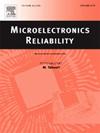通过学习频域反射系数信号模式对电子互连器件进行非破坏性故障诊断
IF 1.6
4区 工程技术
Q3 ENGINEERING, ELECTRICAL & ELECTRONIC
引用次数: 0
摘要
互连的故障检测和诊断对于电子产品的预报和健康管理 (PHM) 至关重要。传统方法依赖电子信号作为预报因素,往往难以在不进行破坏性测试的情况下准确识别缺陷的根本原因。此外,这些方法容易受到噪声干扰,从而导致误报。为了解决这些局限性,我们在本文中提出了一种新型的非破坏性方法,用于早期故障检测和互连缺陷的精确诊断,并提高了抗噪声能力。我们的方法独特地利用了反射系数在一定频率范围内的信号模式,从而实现了根本原因识别和严重性评估。这种方法有别于传统的时间序列分析,能有效地将信号数据转换为适合高级学习算法的格式。此外,我们还引入了一种新颖的严重性评级集合学习(SREL)方法,该方法提高了诊断的准确性和在嘈杂环境中的鲁棒性。实验结果表明,所提出的方法能有效地进行故障检测和诊断,并有可能推广到现实世界的工业应用中。本文章由计算机程序翻译,如有差异,请以英文原文为准。
Non-destructive fault diagnosis of electronic interconnects by learning signal patterns of reflection coefficient in the frequency domain
Fault detection and diagnosis of the interconnects are crucial for prognostics and health management (PHM) of electronics. Traditional methods, which rely on electronic signals as prognostic factors, often struggle to accurately identify the root causes of defects without resorting to destructive testing. Furthermore, these methods are vulnerable to noise interference, which can result in false alarms. To address these limitations, in this paper, we propose a novel, non-destructive approach for early fault detection and accurate diagnosis of interconnect defects, with improved noise resilience. Our approach uniquely utilizes the signal patterns of the reflection coefficient across a range of frequencies, enabling both root cause identification and severity assessment. This approach departs from conventional time-series analysis and effectively transforms the signal data into a format suitable for advanced learning algorithms. Additionally, we introduce a novel severity rating ensemble learning (SREL) approach, which enhances diagnostic accuracy and robustness in noisy environments. Experimental results demonstrate that the proposed method is effective for fault detection and diagnosis and has the potential to extend to real-world industrial applications.
求助全文
通过发布文献求助,成功后即可免费获取论文全文。
去求助
来源期刊

Microelectronics Reliability
工程技术-工程:电子与电气
CiteScore
3.30
自引率
12.50%
发文量
342
审稿时长
68 days
期刊介绍:
Microelectronics Reliability, is dedicated to disseminating the latest research results and related information on the reliability of microelectronic devices, circuits and systems, from materials, process and manufacturing, to design, testing and operation. The coverage of the journal includes the following topics: measurement, understanding and analysis; evaluation and prediction; modelling and simulation; methodologies and mitigation. Papers which combine reliability with other important areas of microelectronics engineering, such as design, fabrication, integration, testing, and field operation will also be welcome, and practical papers reporting case studies in the field and specific application domains are particularly encouraged.
Most accepted papers will be published as Research Papers, describing significant advances and completed work. Papers reviewing important developing topics of general interest may be accepted for publication as Review Papers. Urgent communications of a more preliminary nature and short reports on completed practical work of current interest may be considered for publication as Research Notes. All contributions are subject to peer review by leading experts in the field.
 求助内容:
求助内容: 应助结果提醒方式:
应助结果提醒方式:


